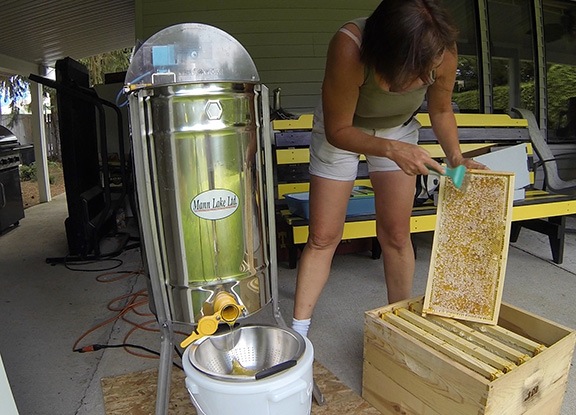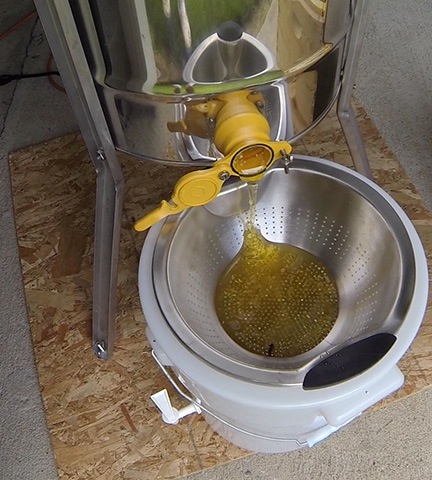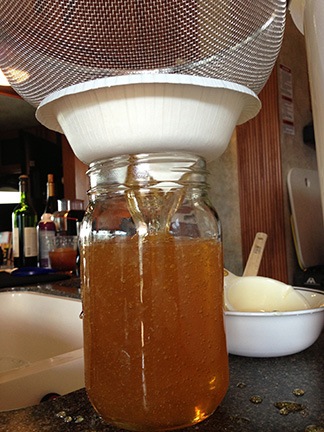I thought I’d take a moment to bring readers up-to-date on my bees and their hives.
I haven’t blogged about my bees in almost a month. That’s because there hasn’t been anything terribly interesting happening with them. But that doesn’t mean there isn’t anything to report.
Hive Move
I have a total of three hives. Two of them were with me where I’m camped out along the side of Squilchuck Canyon in Wenatchee Heights. The third (which was really my first) was at a fellow beekeeper’s house in Wenatchee.
The one in Wenatchee was doing great. So great that they filled seven frames of a deep hive box with capped honey. I extracted honey from six of those frames in July and got a total of about 2-1/2 gallons of honey. I replaced that deep hive box with a medium box and 10 new frames for the bees to continue making honey.
I used the deep hive box that had been on that productive hive as a home for the new hive I’d created a few days before via a hive split. The bees had been living in a nuc box until I could get a deep hive body for them. I set them up in Wenatchee Heights beside the hive I’d created by catching a swarm earlier in the season. I divided the extracted frames and partially filled frames between those two hives, removing any empty frames I had. The bees, I knew, would clean the beeswax cells of those frames and start using them for brood or honey storage. At least that was the idea.
As I discovered on two subsequent hive inspections, however, the bees weren’t producing much honey at all. They cleaned out those sticky frames very quickly, but didn’t refill the cells. One look around the area made it pretty clear why: there simply weren’t enough flowering plants to give them the food source they needed. Even though I was feeding them regularly with a 1:1 sugar water solution, they just weren’t making a noticeable amount of honey.
My beekeeping friend, Jim, confirmed this when he and his wife came over for dinner one night. He suggested that I move the hives down to his place with my other one. He had lots of clover in his grass and there were plenty of gardens in the area. A much better source of food.

My beehives are currently in a friend’s backyard.
So one late July evening, after the bees had gone in for the night, I stuffed rags in the hive entrances to lock them in and used ratchet tie-down straps to secure the bottoms and tops to the two boxes. In the morning, I loaded them onto my pickup truck and drove them down to Jim’s place. I set up some scrap wood to form a platform and positioned the two hives side by side on it. Then I removed the rags, added sugar water to two feeders, and left them.
At this point, all three of my beehives are in Jim’s backyard in Wenatchee.
I have to admit that I’m a bit worried about how they’ll fare when I move them to my future home in Malaga. Although the property is full of wildflowers in the spring and early summer, in late summer it’s about the same as Wenatchee Heights. I suspect that I’ll be feeding my bees quite a bit until my gardens are established.
The Main Hive
I’ll always consider my first hive my “main hive” simply because it’s the healthiest and most active. But I noticed a definite decline in honey production since extracting honey in July and replacing brood frames in the bottom hive body with empty frames when I made my hive split.
Indeed, the bees have yet to produce any comb or store any honey in the medium box that’s now their second level. And it’s been about three weeks.
Yesterday I did an exhaustive hive inspection. Although I didn’t see the queen, I did see fresh brood. And I was very pleased to see that they had begun putting brood in the drone frame. I could kick myself — I should have brought along a fresh drone frame to replace it with. I’ll have to go back sometime this week to do that; the idea is to freeze the frames with drone brood in them as part of a varroa mite prevention strategy. Of course, the frame won’t fit into my RV’s freezer. But there is a freezer in my “landlord’s” garage; I’ll ask if I can store it there.
I removed the queen excluder and Ross Rounds box from that hive to store them for the winter. There’s no way they’ll fill the Ross Rounds before autumn comes. At this point, I doubt they’ll fill the medium frame.
The Hive Split Hive
I blogged about my risky hive split back in July. The way I did the split was admittedly haphazard. I pulled brood frames that included swarm cells out of my main hive and put them in a nuc box with all the bees that were on them. Then I moved them away from the main hive with hopes that a swarm cell would hatch into a queen and the hive would continue. I also hoped that the queen was not among the bees I moved.
I was certain I had failed. The hive was not very active and didn’t seem to be growing. It certainly wasn’t producing much (if any) honey, as I reported above. Every time I inspected it, I’d look hard for a queen or eggs in cells. I did see developing and capped brood but never saw anything fresher.
But in yesterday’s hive inspection, I did something I never did before: I wore my reading glasses. Yes, I’m of “that age” when glasses are necessary to bring tiny things into focus. And what’s tinier than a bee egg?
Surprise, surprise! Not only did I see freshly hatched eggs, but I also spotted a queen. My risky hive split had been a success!
Now if only they’d start storing honey for the winter.
The Swarm Hive
I thought the swarm hive might have stored enough honey for me to add a medium hive body with frames to it. I even brought the hive body with me and unboxed it prior to making my inspection. But the bees simply aren’t working hard enough. There are plenty of empty areas in the frames in their deep hive body. Adding another box on top might coax them into storing honey in the top box before they’d filled the bottom one. I needed to wait.
I also checked the drone frame I’d put on that box. They’re just starting to build out comb. So I’m not very sure how effective the drone frames are for mite control. It seems that the bees are slow to accept them.
Prepping for the Winter
I know it’s only August and the summer’s hottest days are barely behind us. But I do need to plan ahead for the winter. That means ensuring that the bees store up enough honey to feed themselves during the coldest months. This will be especially important since I plan to spend much of the winter traveling and won’t be around to feed them.
With luck, however, I’ll find a good, sheltered spot for them on my new property. That’s one of the chores I face in the months ahead.











